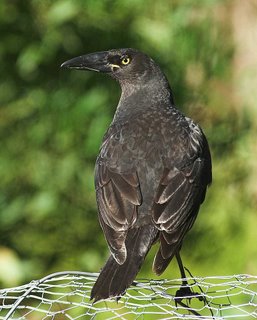 Continuing on my theme of publishing images of Tasmanian endemics while I'm still overseas, today's offering is the Black Currawong. It's probably the most photographed of Tasmania's endemic birds because of its boldness. If you're having a picnic at some of the highland parks, you're probably going to be joined by these birds, and having your lunch snatched by a currawong may be funny at first, but can quickly become a nuisance as they become ever bolder.
Continuing on my theme of publishing images of Tasmanian endemics while I'm still overseas, today's offering is the Black Currawong. It's probably the most photographed of Tasmania's endemic birds because of its boldness. If you're having a picnic at some of the highland parks, you're probably going to be joined by these birds, and having your lunch snatched by a currawong may be funny at first, but can quickly become a nuisance as they become ever bolder.The Black Currawong is an altitudinal 'migrant', inhabiting the highland areas during the warmer months, and lower areas during the Winter. At times they form flocks of upto a hundred or so. The
 similar,Grey, or Clinking Currawong, is rarely seen with this species, prefering drier areas. The lower image, shows a juvenile bird, with a browner appearance, and a yellow gape.
similar,Grey, or Clinking Currawong, is rarely seen with this species, prefering drier areas. The lower image, shows a juvenile bird, with a browner appearance, and a yellow gape.This weekend I'm attending a seminar on hawk ID, organised by the Illinois Ornithological Society. Hawk watching here is a big event, as many migrant hawks pass this area (Western shores of Lake Michigan), on their journey South. And I'm talking about many thousands of birds, of around a dozen species, that are the subject of an annual count by birders here. I've also managed to score a few personal firsts ('lifers', in the jargon of birders), including Stilt and Upland Sandpipers (several of each, actually), both rare vagrants to Australia.
6 comments:
Hi Alan,
glad to hear your US trip is still going well. It must be a sight to see all those migrating raptors!
I concur with your comments about the highland/lowland, and moister/drier distribution of our currawongs - except that on King Island (all very 'lowland'), they only have blacks (though I thought noticably different to the mainland race), and on the Tasman peninsula, we have encountered both species in close proximity to each other on a number of occasions.
well. its Spring at the base of the Mountain in Cascades and the Blacks are chorussing in big operas for the past few days, and I was wondering where are the greys? haven't heard them for a while now, I recorded an opera of theirs yesterday, and then today amidst the opera were some faint clinkers joining in, greys on the next ridge.
I guess they'll be heading uphill soon
Hi Alan,
Have visited the blog a number of times recently, checking for new postings, but only just noticed this evening, that the top pic on this post about the Currawongs is quite interesting. Apart from the (usual) hooked tip of the Black Currawongs' beaks, the bird in the top shot looks to have a BENT beak, about half way along. Do you recall whether this was in fact the case, or is it just an illusion of the particular shot? Some birds do show deformities in their beaks, but if this one does have a bent beak, it obviously doesn't hinder it too much - it looks quite healthy. It's often interesting to see what degree of leg, beak, wing, or other deformity a bird can function quite normally with. I've been following the info about the Grey-headed Lapwing that has turned up in New South Wales, and apparently it's functioning quite well with quite a deformed foot.
Hi John, No I hsdn't noticed any abnormality in that bird. I had made a fleeting visit to Mt Field N.P. and photographed thess birds at the entrance. Most appeared to be young birds, with a few adults, all waiting for 'free' handouts from visitors. Had hoped for rather better pix.
Hi Meika,
I saw our first Grey in our vicinity on Sunday. It was on the Domain. We have seen them on Knocklofty, and the Eastern Shore, but this was the first we'd seen on the Domain, or nearby to home. Haven't seen any Blacks in close to the city.
During my 18 years in Summerleas Rd Fern Tree, large numbers of Black and Grey Currawongs often came together in my garden in the Autumn and Winter months, an interface of dry woodland and wet forest habitats. The Black Currawong flocks of upto 40 birds in up to three separate flocks, comprised a very high proportion of young birds-juvenile, first and second year birds.
Post a Comment